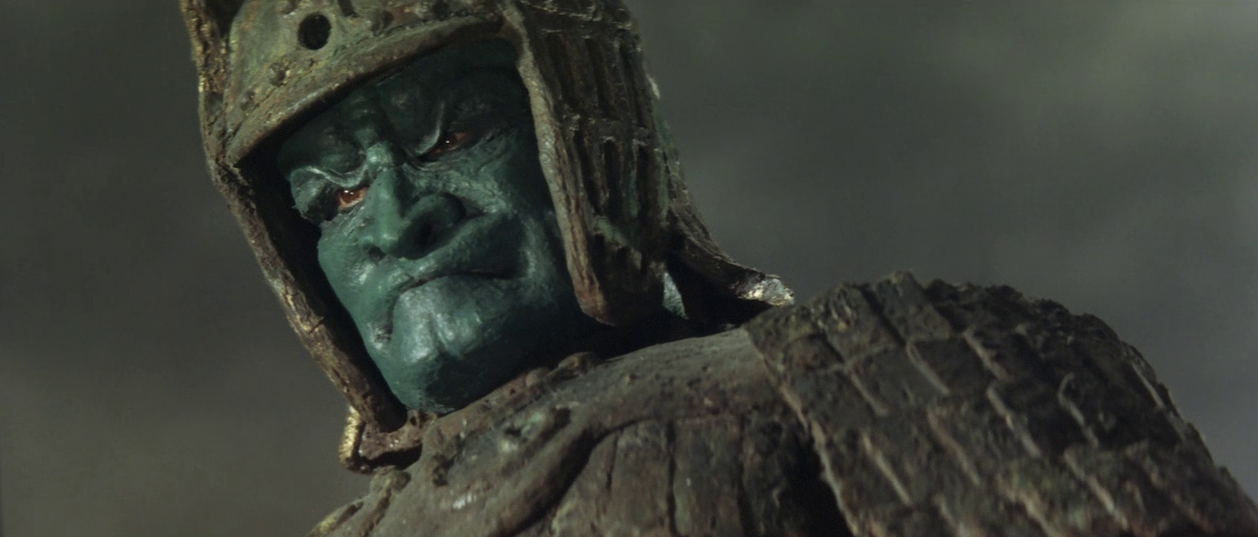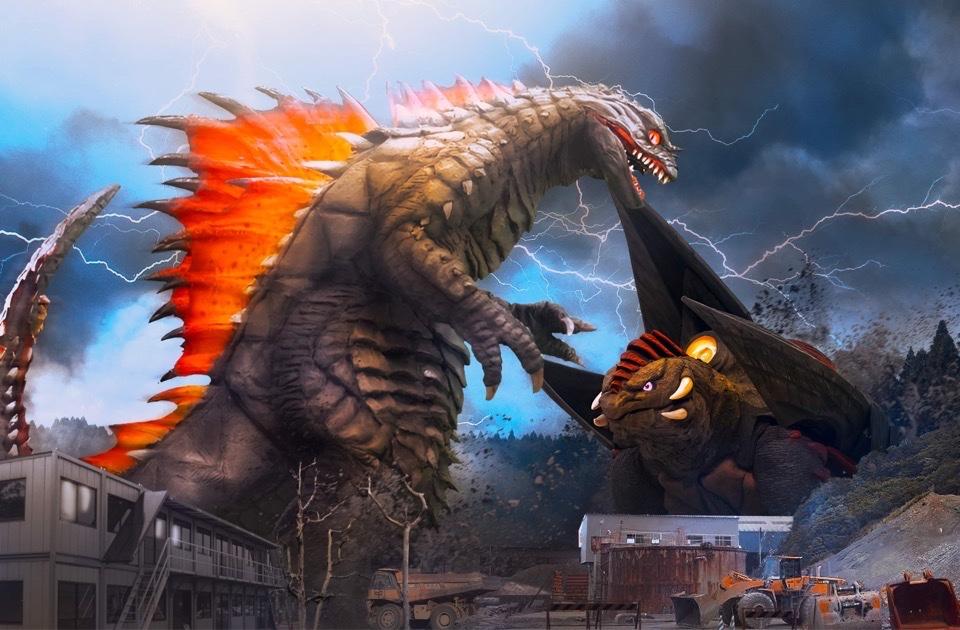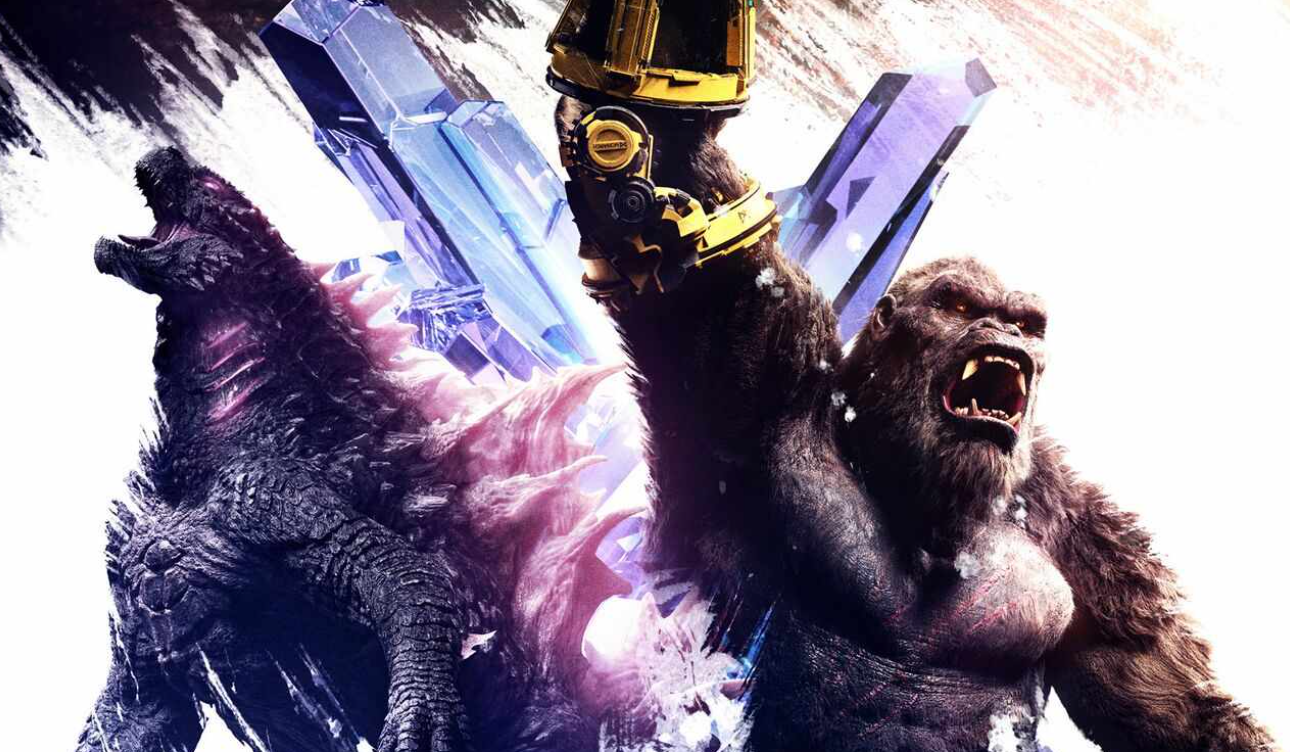Gamera is undoubtedly a kaiju icon, yet the giant turtle isn’t the only prominent tokusatsu figure out of Daiei Studio/Kadokawa Daiei Studio. Besides the friend of all children, there is the great demonic god Daimajin. Inspired by the golem depicted in the 1936 Czechoslovakian monster movie Le Golem by Julien Duvivier, the wrathful deity was originally planned as a Gamera foe but ultimately established to be its own thing. Conceived in the mind of art director Akira Naito and designed by Shozo Okamoto, the angry demon was created as a powerful spirit that, when awakened, takes the physical form of a possessed statue, with a design heavily inspired by statues and idols from around the world, particularly those of the powerful guardians of Buddha known as Nio.
The character was set to debut in a trilogy of movies released in 1966, made simultaneously by three different filmmakers on big budgets and primarily with the same production crew. These movies would contain similar premises and narrative structures set in feudal Japan, culminating with the powerful god Daimajin saving villagers from corrupt warlords. With the Japanese film industry slowing and heading towards a financial decline due to the advent of television, the producers at Daiei Studio were certain Daimajin would help shine hope for Japan’s movie productions going forward. Yet, despite the critical and financial success of all three features, it proved to be in vain as Japanese cinema would still ultimately fall into a budgetary slump in the late 1960s that would carry on throughout the 1970s. Yet, the impact Daimajin has had on Japanese cinema is undeniable, as it would have a legacy in the years to follow, certainly helped by theatrical re-releases and the growing attention the character would gradually receive
internationally. The powerful spirit would even have subsequent appearances in future media with the television series Daimajin Kanon and, more recently, Takashi Miike’s film The Great Yokai War: Guardians.

Dialing back, the character’s first feature, Daimajin, also known as Great Demon God, is a great film and among the best tokusatsu pictures, period. It is directed by Kimiyoshi Yasuda, who served as an assistant director to prominent filmmakers, including Sadao Yamanaka and Hiroshi Inagaki. Yasuda’s filmography includes numerous entries in the Zatoichi film series and Yokai Monsters: 100 Monsters. As previously highlighted, when released, Daimajin was a critical and financial hit in Japan, certainly helped by being released simultaneously with Gamera vs. Barugon. It would premiere in America with an English Dub on television in 1968 under Majin, the Monster of Terror.
Set in feudal Japan, a village within the Tanba Province is in a state of panic due to a series of earth tremors believed to be the powerful, violent spirit Arakatsuma, also known as Daimajin, trying to escape his enclosure from the mountains. The villagers gather around the shrine to perform an ancient ritual led by priestess Shinobu to tame the demon’s wrath. While this happens, chamberlain Samanosuke plots against the local lord Tadakiyo Hanabusa, successfully carrying out a coup d’etat, killing Hanabusa and his wife. However, their two children, Kozasa Hanabusa and Tadafumi Hanabusa, are saved by a samurai named Kogenta Sarumaru. With their parents dead, Kogenta and Shinobu take the princess and prince into the mountains, where the idol of Daimajin resides as the traitorous chamberlain assumes power.
Ten years pass; the children are now adults, and Samanosuke has become a powerful warlord, continuing his corrupt expansion at the villager’s expense. When Kogenta and eventually Tadafumi attempt to rescue
the villagers from the rule of the sadistic overlord, they are captured and set to be publicly executed. Shinobu confronts Samanosuke and warns that his crimes against humanity will enrage and awaken Daimajin, but this tragically backfires. Thus, Kozasa has no choice but to pray to the idol in the mountains for Daimajin to awaken and save her brother and the villagers from Samanosuke’s rule, even offering her life in return.
As familiar as this type of plot is, essentially a grim fairytale, the overall storytelling and narrative progression of Daimajin is executed marvelously. This success is largely due to Kimiyoshi Yasuda’s tight direction and a strongly written screenplay by Tetsuro Yoshida, who would also write the two subsequent sequels. For one, there’s an amazing build-up for Daimajin’s eventual appearance, with many fearing his wrath, while some believe he can help those who are innocent. Others downright think the legend surrounding him is fictitious, with Samanosuke believing the angry god is a myth and merely religious nonsense, something he would regret later. Viewers are teased about what this spirit is, with the statue residing in the mountainside serving as an eerie omen of what’s to come. When he eventually awakens and possesses the stone idol, the feeling of awe is overwhelming when the audience sees how powerful and terrifying this entity is in a spectacular finale that is a great payoff.
Additionally, this movie takes advantage of the period setting of feudal Japan and how it approaches its narrative concepts. Even with this being a fantasy jidaigeki film, much of what is depicted here certainly rings true in this time frame of Japanese history. Many warlords who assumed power reveled in corruption and devalued human life, taking advantage of those weaker than them for their pleasure. It’s easy to sympathize with the villagers that Samanosuke abuses, for they were entirely forced into this imprisonment. We even get to know them closer through a little boy who wishes for his imprisoned father to return home, all while his mother is dying.
Furthermore, viewers can also empathize with Kozasa and Tadafumi, for their world was turned completely upside down during their childhood by the senseless slaying of their parents, with Shinobu and Kogenta now being the closest thing to parental figures in their lives and indoctrinated into carrying on their royal legacy as the next of kin. Ultimately, this time’s preconceived notions of social class are set aside in favor of the humane theme of wronged people helping one another against a corrupt authority.
One could say this is a story of going beyond restoring the status quo and prioritizing morality during a dark time, yet that is tested when a destructive higher power becomes involved. Many aspects of Daimajin himself are also clear influences of religions practiced in Japan for centuries, including Buddhism, Shintoism, Christianity, and Confucianism, and fascinations with folklore, such as the supernatural spirits known as yokai. Having some of Daimajin’s powers, including manipulating the Earth to reign destruction with earthquakes and heavy winds, makes him feel like a biblical figure straight out of the Old Testament.
Helping enrich Daimajin is really good characters. Miwa Takada is great as Kozasa Hanabusa, bringing so much likability to her role, and the lengths she’s willing to go to help her brother and the villagers highlights her humanity, right down to being the one to awaken Daimajin as a last resort to help the innocent and offering her life in return. It’s also a great way to subvert viewer expectations, as initially, we are led to believe Tadafumi Hanabusa, being the heir to the throne, is set to be the hero to save the villagers from slavery, only then to be captured by Samanosuke, showing our young hero still has a lot to learn. Even with his stubbornness, he still makes for a compelling protagonist, certainly helped by a lively portrayal from Yoshihiko Aoyama. The surrogate guardians of the two heroes are just as memorable, with Jun Fujimaki bringing coolness to Sarumaru Kogenta and Otome Tsukimiya having a commanding presence as the priestess Shinobu while also occasionally showing a motherly side. Samanosuke makes for a great villain, the guy the audience loves to hate, and Ryutaro Gomi certainly looks like he’s having fun playing the role of the evil warlord. Also surprisingly good is Ryutaro Gomi as the boy Take-bo, the son of one of the enslaved people who ends up helping the heroes in their course of action.
One more character needs to be discussed: Arakatsuma, Daimajin himself. Even with minimal screen time, this movie solidifies the Giant Demon God as one of the greatest characters in all Tokusatsu media. The design itself is wonderful, with the gigantic sentient statue dawning the appearance of an armored samurai warrior that initially appears stoic with a flat face but, when awakened, becomes noticeably bulkier with a green-faced angry scowl and piercing eyes, conveying pure anger and destined to punish the wicked. However, viewers will learn that with such power released, it becomes hard for the devilish stone behemoth to control its rage, showing this isn’t some perfect messiah-like figure but one prone to unimaginable destruction, which makes this character all the more terrifying. Yet, Kozasa’s humane actions when communicating with the spirit hint that this higher power can still be reasoned with. On that note, while the character is massive, he’s also smaller than your average kaiju, and the fact that he directly
interacts with the humans makes his encounters with them feel more personal.
All of these elements of Daimajin himself come together wonderfully through a truly mesmerizing performance from the actor playing the angry god, Chikara Hashimoto. Hashimoto was notably a professional baseball player yet was also active as an actor. Most moviegoers will remember him best for playing Hiroshi Suzuki in the Hong Kong martial arts film Fist of Fury, starring Bruce Lee. For Daimajin, Hashimoto, through his body language and movements, makes it believable that this is a stone statue that has come to life, as well as one capable of inflicting destruction. Another aspect of where his performance shines is through his eyes. Even with the actor wearing a mask with an angry frown, Hashimoto’s real eyes are visible, and he uses them to convey the god’s emotions, particularly the unabashed rage he feels, which especially hits hard during the film’s climax when Daimajin closes in on Samanosuke. Viewers can see the pure hatred he has for the sadistic warlord. Yet, there are nice subtleties to Hashimoto’s performance, such as how his eyes soften when Kozasa begs him not to inflict his wrath upon the villagers.
On a production level, Daimajin is spectacular and showcases what Daiei Studio could pull off with a big budget, as previously highlighted in classics like Akira Kurosawa’s Rashomon and Kenji Mizoguchi’s Ugetsu. The set pieces and costumes are beautiful, and the cinematography by Fujio Morita remains gorgeous throughout. The special effects directed by Yoshiyuki Kuroda are fantastic, with magnificent miniature work and solid blue-screen compositing. The Daimajin suit looks great, effectively maintaining that this creature is made of stone. Occasionally, a gigantic mobile full-scale model is used for the actors to interact with, as well as giant hands. While these techniques are perhaps noticeable by today’s standards, they are still impressive.
The highlight would be the monster’s climatic destruction scene when he rampages through Samanosuke’s fortress, set to a fiery red/green sky and heavy winds, while the villains scream in terror as Daimajin approaches with each thunderous footstep. Being a period film, it’s also neat to see the humans use more primitive tactics to try and battle the titular kaiju, including chains, catapults, and fire. The rest of the traditional samurai action throughout the feature is also great. The film is also quite violent, with some surprisingly shocking death scenes. Akira Ifukube’s music score is phenomenal: brooding, dark, and epic when it needs to be, yet also knows when to dial down and be appropriately sad, mysterious, and heartfelt. Ifukube would even rework some of the music when he scored Godzilla vs. King Ghidorah.
What else can be said about Daimajin? It’s a classic, plain and simple. While the subsequent sequels that followed, Return of Daimajin and Wrath of Daimajin, are also enjoyable, the original stands above, thanks to a strong story and outstanding spectacle.





